
(CLICK IMAGES TO ENLARGE)
Three names were influential in the development of what would become the Greenwood Marching Woodmen. Greenwood residents may recognize the names of Craig and Polk. But, it’s not likely you are familiar with the third name—Shadley.
No one person can take credit for the success, tradition and legacy of the Greenwood Marching Woodmen. But one person can take credit for starting it all. That person is Maurice Shadley. Maurice was a typical Greenwood student. He was hard working and driven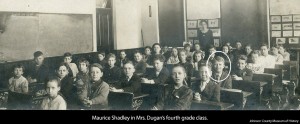 with a passion for music. But Maurice had to look outside of his school to indulge his musical abilities. Maurice’s Greenwood of the early 1900s was very different than the Greenwood of 2016.
with a passion for music. But Maurice had to look outside of his school to indulge his musical abilities. Maurice’s Greenwood of the early 1900s was very different than the Greenwood of 2016.
Let’s back up a bit for a brief history of Greenwood schools. Greenwood was incorporated as a town in 1864 and the first school building was built that same year. It contained four classrooms which was adequate at the time since the new 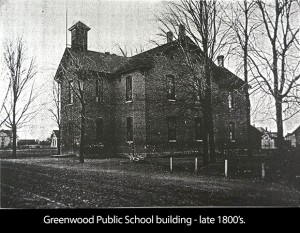 town had only about 300 residents. Unfortunately, the school was short-lived as it burned down in the winter of 1865 and classes were temporarily moved to a house on East Main Street. A new four-room school building was opened in 1868. This building was modified and expanded numerous times until it was decided it could no longer accommodate the growing student population. A new school was commissioned in 1901 for $17,000.00 with a separate classroom for each of the twelve grades. This was Maurice’s Greenwood School. It was soon supplemented by the Central Elementary School in 1906.
town had only about 300 residents. Unfortunately, the school was short-lived as it burned down in the winter of 1865 and classes were temporarily moved to a house on East Main Street. A new four-room school building was opened in 1868. This building was modified and expanded numerous times until it was decided it could no longer accommodate the growing student population. A new school was commissioned in 1901 for $17,000.00 with a separate classroom for each of the twelve grades. This was Maurice’s Greenwood School. It was soon supplemented by the Central Elementary School in 1906.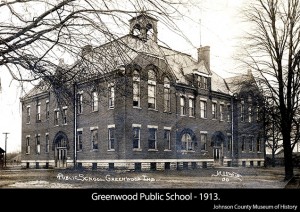
When Maurice was born in 1909, Greenwood had grown to over 1,600 residents, but it remained a tiny, rural farming community. Like most schools that size, they had music classes, but did not have the resources to support a band program. But, Greenwood did have a band.
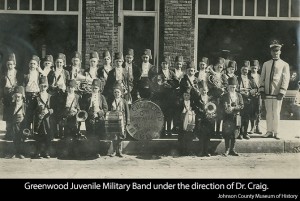 Greenwood’s first band was not affiliated with the school. It was collectively known as the Greenwood Juvenile Military Band. It was organized by prominent Greenwood Physician Dr. James Albert Craig. Dr. Craig worked tirelessly to recruit new members for the band and organized their performances in many cities around the state. He also played a significant role in helping band members find work to pay for their instruments. He jokingly stated that there were no juvenile delinquents in Greenwood because he kept them all too busy with the band. Maurice played trombone in Dr. Craig’s band as a teenager in the mid 1920s. He traveled with the band throughout Indiana by car and up and down the interurban line.
Greenwood’s first band was not affiliated with the school. It was collectively known as the Greenwood Juvenile Military Band. It was organized by prominent Greenwood Physician Dr. James Albert Craig. Dr. Craig worked tirelessly to recruit new members for the band and organized their performances in many cities around the state. He also played a significant role in helping band members find work to pay for their instruments. He jokingly stated that there were no juvenile delinquents in Greenwood because he kept them all too busy with the band. Maurice played trombone in Dr. Craig’s band as a teenager in the mid 1920s. He traveled with the band throughout Indiana by car and up and down the interurban line.
As another bit of Greenwood history, the interurban was a series of electrically powered streetcars running on tracks. They ran down 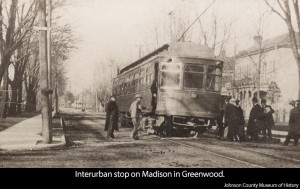 Madison Avenue in Greenwood on a set schedule much like buses of today. They were in operation from 1900 to the 1940s when the improved roads and the increased availability of automobiles made them unnecessary. In 1901, the Indianapolis to Greenwood line was extended to Franklin and by 1908 it ran through to Louisville. The Indianapolis interurban hub was the largest in the nation. Subtle remnants of the interurban system remain in Greenwood. Stop 10, 11, 12, 13 and 18 Roads are not named after stoplights or bus stops. They are the numbered interurban stops from Indianapolis. Most interurban stops were renamed over the years, but these few remain as a legacy to the old transit system.
Madison Avenue in Greenwood on a set schedule much like buses of today. They were in operation from 1900 to the 1940s when the improved roads and the increased availability of automobiles made them unnecessary. In 1901, the Indianapolis to Greenwood line was extended to Franklin and by 1908 it ran through to Louisville. The Indianapolis interurban hub was the largest in the nation. Subtle remnants of the interurban system remain in Greenwood. Stop 10, 11, 12, 13 and 18 Roads are not named after stoplights or bus stops. They are the numbered interurban stops from Indianapolis. Most interurban stops were renamed over the years, but these few remain as a legacy to the old transit system.
The third influencer in the development of music in Greenwood is Polk. James (J. T.) and Laura Polk began the J. T. Polk Canning 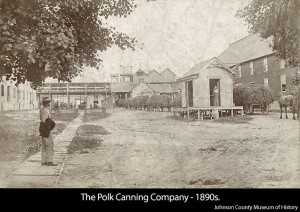 Company in the kitchen of their Greenwood home in 1872. It grew to be Greenwood’s largest employer as well as one of the largest canning companies in the U.S. In addition to workers at their plant, the Polks contracted with over 150 farmers to grow fruits and vegetables for canning. A dairy was added in the late 1800s. When James Polk died in 1919, his will provided a generous fund for the construction of a community building for the residents of Greenwood. This is the thread that leads us back to Maurice Shadley. The Polk Community House at
Company in the kitchen of their Greenwood home in 1872. It grew to be Greenwood’s largest employer as well as one of the largest canning companies in the U.S. In addition to workers at their plant, the Polks contracted with over 150 farmers to grow fruits and vegetables for canning. A dairy was added in the late 1800s. When James Polk died in 1919, his will provided a generous fund for the construction of a community building for the residents of Greenwood. This is the thread that leads us back to Maurice Shadley. The Polk Community House at 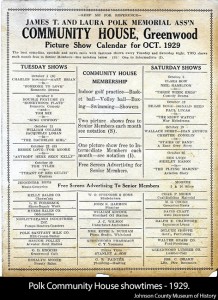 Madison and Broadway was a focal point for the Greenwood community. The building contained a kitchen, meeting rooms, swimming pool, gymnasium, library and an auditorium for plays, movies and live music. The mood of the country shifted dramatically in the post-World War I roaring twenties. It was a carefree time of entertainment and the Polk Community House fit the bill as public music performances were in high demand. So, naturally, Maurice performed there often with Dr. Craig’s band.
Madison and Broadway was a focal point for the Greenwood community. The building contained a kitchen, meeting rooms, swimming pool, gymnasium, library and an auditorium for plays, movies and live music. The mood of the country shifted dramatically in the post-World War I roaring twenties. It was a carefree time of entertainment and the Polk Community House fit the bill as public music performances were in high demand. So, naturally, Maurice performed there often with Dr. Craig’s band.
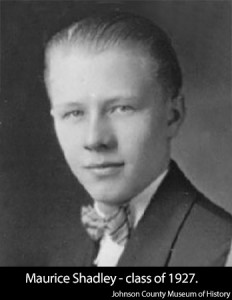 While in high school, Maurice also studied at the Metropolitan School of Music in Indianapolis. He graduated from Greenwood in 1927 and was awarded a Rector Scholarship to DePauw University. In addition to performing music, Maurice wanted to pass his love of music on to others as an educator. He transferred to Indiana Central College where he was director of the orchestra as well as a member of the touring vocal group the Greyhound Quartet. In 1930, Maurice organized and directed the first Greenwood Concert Orchestra. The purpose of the 20-member group was to provide music
While in high school, Maurice also studied at the Metropolitan School of Music in Indianapolis. He graduated from Greenwood in 1927 and was awarded a Rector Scholarship to DePauw University. In addition to performing music, Maurice wanted to pass his love of music on to others as an educator. He transferred to Indiana Central College where he was director of the orchestra as well as a member of the touring vocal group the Greyhound Quartet. In 1930, Maurice organized and directed the first Greenwood Concert Orchestra. The purpose of the 20-member group was to provide music 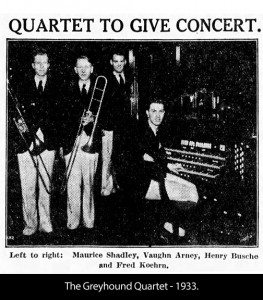 for community affairs including the live theater shows at the Polk Community House. Within four years, the membership grew to 35. After graduating from Indiana Central in 1932, Maurice continued his college career and received his Masters and Ed.D. degrees from the Arthur Jordan Conservatory of Music and Indiana University respectively. Now a professional music educator, Dr. Shadley was in demand teaching orchestra, band and choir at local high schools—including Smithville and Bridgeton.
for community affairs including the live theater shows at the Polk Community House. Within four years, the membership grew to 35. After graduating from Indiana Central in 1932, Maurice continued his college career and received his Masters and Ed.D. degrees from the Arthur Jordan Conservatory of Music and Indiana University respectively. Now a professional music educator, Dr. Shadley was in demand teaching orchestra, band and choir at local high schools—including Smithville and Bridgeton.
From 1925 to 1935, music festivals for local schools began developing. They continued to gain in popularity until it was decided that a formal association should be created to develop and sponsor these events. Due to the travel time across state in the 1930’s, it was decided that two associations would be formed. Not only was there no interstate 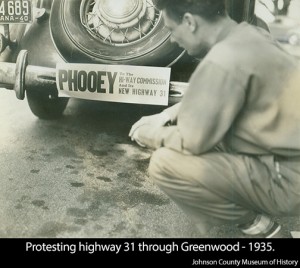 system, highway 31 didn’t even exist at this time. It was finally completed and opened for Thanksgiving travelers in November 1936, despite some local protests.
system, highway 31 didn’t even exist at this time. It was finally completed and opened for Thanksgiving travelers in November 1936, despite some local protests.
The state was split into north and south associations. The north formed the Northern Indiana School Band, Orchestra, and Vocal Association (NISBOVA). The south formed the Indiana School Music Association (ISMA). These two associations formed in 1935. Since Greenwood had always been an enthusiastic supporter of local bands, School Superintendent, and high school principal, Earl Wood decided it was time for a Greenwood school band. So, when a vacancy was left by outgoing music teacher Edith Stahl, Wood began recruiting for a new 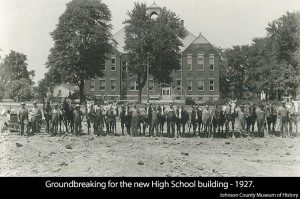 teacher up to the task. It wasn’t long before he was in touch with Dr. Shadley. Maurice accepted the position and began teaching band and english at the new High School in the fall of 1936. The first Greenwood High School band had 28 members. If that seems underwhelming, it’s important to note that the entire high school student enrollment was only 123.
teacher up to the task. It wasn’t long before he was in touch with Dr. Shadley. Maurice accepted the position and began teaching band and english at the new High School in the fall of 1936. The first Greenwood High School band had 28 members. If that seems underwhelming, it’s important to note that the entire high school student enrollment was only 123.
The music department hosted the Indiana Central College band at the invitation of Dr. Shadley in December. Members of the Greenwood band also performed at the concert. The new Greenwood band performed at ISMA Band, Orchestra, Solo and Ensemble competitions as well as school and community events. They won 1st place at District competition for orchestra in Class D and also finished 1st at the state level in Shelbyville. They moved up to class C in 1938. Requirements for that early competition include the playing of “Overture Militaire” by Skornicka, “Dublin Holiday” by Buchtel as well as a one-mile march while playing past the judge’s review stand.
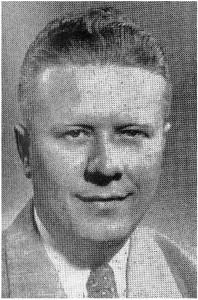 Dr. Shadley was soon tempted away from Greenwood. He only stayed for three years and then joined the faculty of the I.U. School of Music. He was also the director of the I.U. Music Clinic and coordinator of the Public Music Services. During World War II, Dr. Shadley served in the Navy on convoy duty in the North Atlantic. After the war he was involved in numerous musical organizations and symphony orchestras. In 1963, Dr. Shadley was selected by The School Musician Magazine as one of the Ten Most Outstanding Music Directors in the United States of America. Also in 1963, Dr. Shadley resigned from I.U. for a position with the professional staff of Phi Delta Kappa International for music education. In that capacity, he traveled over one million miles throughout Europe and Asia where he helped to establish chapters and acted in an advisory capacity. He retired in 1975 at age 66, but he didn’t slow down. He remained an active participant at music education events.
Dr. Shadley was soon tempted away from Greenwood. He only stayed for three years and then joined the faculty of the I.U. School of Music. He was also the director of the I.U. Music Clinic and coordinator of the Public Music Services. During World War II, Dr. Shadley served in the Navy on convoy duty in the North Atlantic. After the war he was involved in numerous musical organizations and symphony orchestras. In 1963, Dr. Shadley was selected by The School Musician Magazine as one of the Ten Most Outstanding Music Directors in the United States of America. Also in 1963, Dr. Shadley resigned from I.U. for a position with the professional staff of Phi Delta Kappa International for music education. In that capacity, he traveled over one million miles throughout Europe and Asia where he helped to establish chapters and acted in an advisory capacity. He retired in 1975 at age 66, but he didn’t slow down. He remained an active participant at music education events.
In January 1994, Jon Sutton was attending the Indiana Music Educators Conference. He was celebrating his 10th year as Director of the Greenwood Marching Woodmen. His impressive record as a music educator had earned him induction into the Phi Beta Mu honorary fraternity for outstanding band directors throughout Indiana. The induction was to take place at a Phi Beta Mu meeting during the conference. Also attending this meeting was one of the original inductees, Dr. Maurice Shadley. A third party introduced the two men. Dr. Shadley relayed his story of the founding of the Greenwood band almost 60 years earlier. Mr. Sutton followed up that meeting with a phone call to Dr. Shadley later that year. Maurice did finally settle down. He remained close to his beloved I.U. in a retirement community in Bloomington. Dr. Shadley passed away in 2007 at age 97.
Very few records from the beginning of the Greenwood band have survived. The High School building was destroyed in a fire in 1942. But even though there isn’t a collection of photos and trophies from his short time at Greenwood, Maurice Shadley is responsible for initiating a program that has continued to grow and thrive for 80 years, and will continue for many years to come.
Add your voice to the story. Add a comment below. All comments are moderated before posting.
All contents are © Greenwood Community High School. All rights reserved. Attribution of photographs has been given when known.


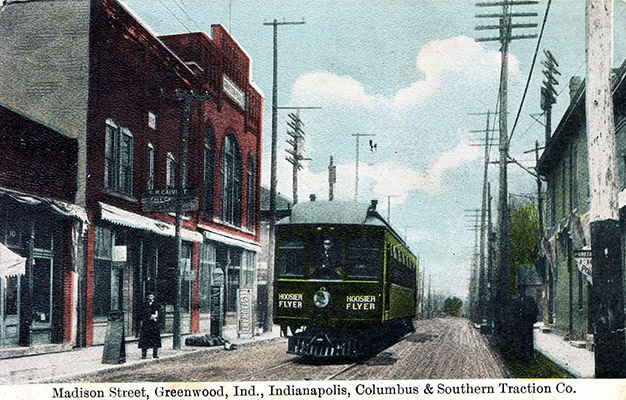

Our school song used to have two parts. The second part was an original composition called “Greenwood Woodmen” and I think Dr. Shadley is the director who wrote it.